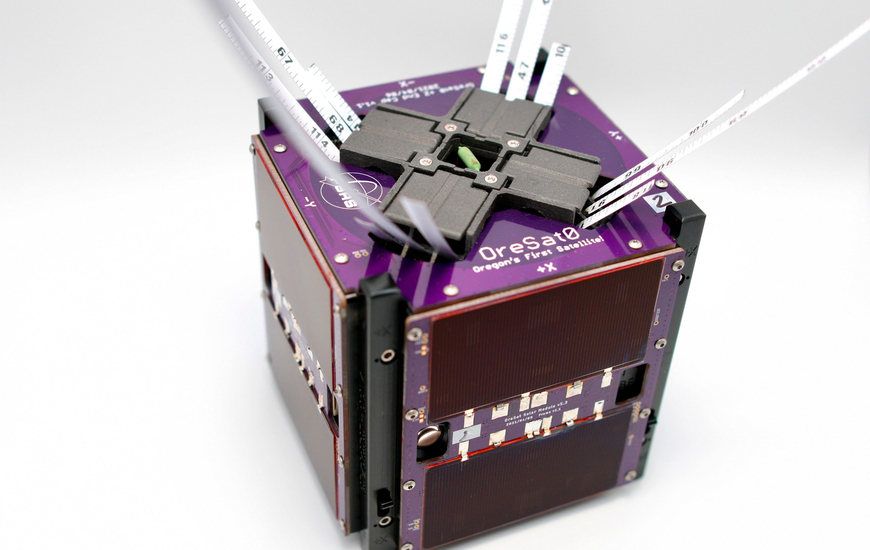Kilogram-class satellites, like CubeSats, now have functionality that were only available in larger 100 to 1,000 kg class satellites. Recently, 3D printing has helped speed up this revolution, especially in universities. CubeSats have been launched by dozens of countries, universities and companies all around the world.
And the state of Oregon joined them recently thanks to the Portland State Aerospace Society (PSAS) that built OreSat0, their very own artisanally hand-crafted CubeSat system, currently in low Earth orbit. This achievement was possible thanks to the use of Windform LX 3.0 and industrial 3D printing L-PBF (Selective Laser Sintering) in their most critical subsystems.
Windform LX 3.0 is a glass fiber reinforced material from the Windform TOP-LINE range of composite materials for Powder Bed Fusion 3D printing process (Selective Laser Sintering) created by CRP Technology.
For OreSat project 3D printing process and Windform LX 3.0 were supplied by CRP USA.
The OreSat bus project
The Portland State Aerospace Society is an open source, interdisciplinary student aerospace project at Portland State University in Portland, Oregon, with collaborators at most other Oregon universities.
They currently have three satellite missions in the works. All rely on the fully open source OreSat bus: “OreSat is our fully open source, modular, and re-usable CubeSat system designed for educational teams”, said PSAS members. “OreSat uses a card cage system, which allows cards to be reused on different missions from 1U to 3U CubeSats. Cards include everything you would expect aboard a CubeSat: an on-board computer with multi-band radios, a battery pack, a star tracker, a GPS receiver, and the beginnings of an attitude determination and control system (ADCS). Solar modules are mounted on the outside of the Aluminum frame, along with deployable omnidirectional antennas. There are very few open source satellites in the world, and ours is probably the most fully featured.”
OreSat0 was deployed into low earth orbit on March 15th, 2021 and has been successfully operating since then. OreSat0.5 is being readied for flight in October 2023, and OreSat1 is scheduled for a deployment off of the international space station in early 2024.
Using industrial 3D Printing and Windform
Before employing Selective Laser Sintering and Windform LX 3.0 for manufacturing subsystems on OreSat0, PSAS members used other additive technologies without achieving the desired results.
Laser Sintering, used without Windform LX 3.0 material, also gave partial results. PSAS members added: “SLS 3D printing worked extremely well. But we couldn’t find SLS parts that could stand the temperature extremes and that were vacuum rated to NASA and ESA outgassing standards.”
The turning point came with the CRP Technology’s Windform range of composites and CRP USA as a technology supplier: “We were absolutely thrilled to find Windform LX 3.0! It absolutely changed the way we design all parts of our satellite thanks to its characteristics: Windform LX 3.0 can be used in space; it has extremely good material properties; it is extremely easy to work with; it is far superior to other 3D printing materials, including the other FDM, SLA, and SLS technologies that we’ve used.”
OreSat0 Systems Printed in Windform LX 3.0
Windform LX 3.0 allowed the PSAS team to use 3D printing on their critical subsystems, including their extremely reliable deployer for their tri-band turnstile antenna. The antenna has three separate antennas (UHF at 436.5 MHz, L band at 1.265 GHz, and L1 at 1.575 GHz) each with 4 elements; all 12 of these elements are deployed using nylon monofilament lines and only a single melt resistor.
Moreover, thanks to CRP’s Windform LX 3.0, PSAS members were able to mount their star tracker sensor and lens on a small daughterboard that kept the entire assembly to a single 10 mm tall card form factor.
The composite was used for battery back as well: The battery pack needed to reliably hold 18650 cells through vibration testing while also providing thermal and electrical insulation from the rest of the satellite. Windform LX 3.0 allowed PSAS to make an extremely compact battery assembly that was still extremely rugged.
Before integration into the launch vehicle, OreSat0 (with 3D printed parts in Windform LX 3.0) was subjected to the following testing: Three axis 14 g random vibration, -40 to +80 °C thermal cycling, and vacuum cycling. Windform performed flawlessly for all of these tests.
In the photo: OreSat0 with solar modules and deployed tri-band turnstile antenna. Courtesy PSAS
-

-
09 March 2023























